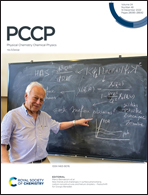Origin of humidity influencing the excited state electronic properties of silicon quantum dot based light-emitting diodes†
Abstract
One of the challenges of silicon quantum dots (Si QDs) in practical application as quantum dot-based light-emitting diodes is the irreversible degradation induced by humid conditions, revealing their excited state electronic properties strongly influenced by the surface water; however, the photoluminescence (PL) mechanism associated with the change of excited state electronic properties remains elusive. Here, we performed the time-dependent density functional theory calculations to investigate how the PL of Si29H36, as typical spherical Si QDs, is determined by dipole–dipole interactions between water molecules and different surface substituent groups. Relative to the hydrophobic group of pure hydrogen passivation, the substituent effect with a hydrogen atom replaced by a fluorine atom almost has no influence on the PL of Si QDs with the adsorption of water clusters. Interestingly, although a hydrophilic hydroxyl group substitution itself will partly change the surface state with the slight blue-shift of PL, the intensive dipole–dipole interaction between a hydroxyl group and water molecules can drastically induce the delocalized electrons to be localized, resulting in a dual-band peak observed in the PL spectra of Si29H35OH surrounded by four or five water molecules. This distinct PL mechanism originates from the adsorption of water molecules through dipole–dipole interactions inducing the existence of surface trap states. The presence of highly polarizable double-bonded oxygen will trigger the electron distribution centered on the silicon–oxygen double bond, resulting in the corresponding PL spectrum of Si29H35O unaffected by the water molecules. This study reveals that the PL of Si QDs with the substituent hydroxyl group is extremely sensitive to humidity and lays a foundation for the practical application of Si QDs as optoelectronic devices.



 Please wait while we load your content...
Please wait while we load your content...